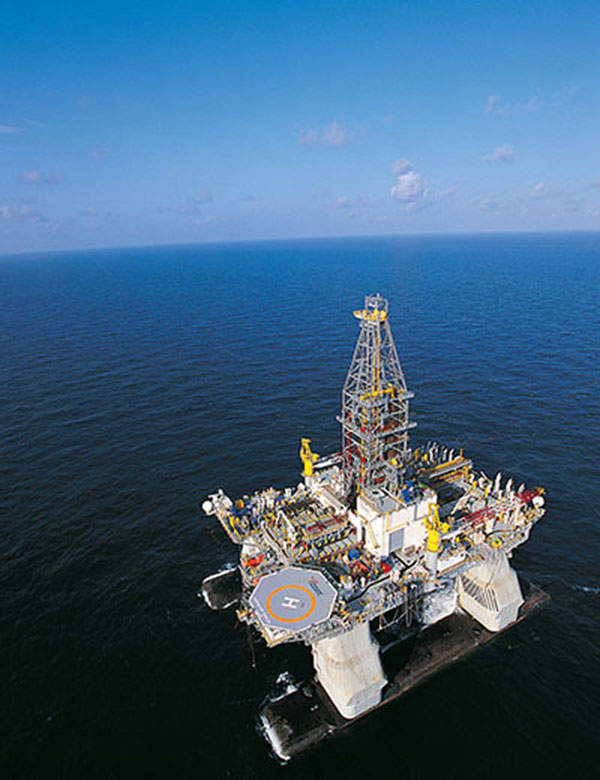Tubular Bells is a deepwater oil and gas field located in Mississippi Canyon Block 725 of the US Gulf of Mexico (USGoM).
The field lies in water depths between 1,310m and 1,400m, and is situated approximately 217km south-east of New Orleans, Louisiana.
Development drilling at the field began in 2012 and initial production was achieved in November 2014, after receiving necessary clearances from the government. The development cost of Tubular Bells is estimated to be $2.3bn.
Hess Corporation, an integrated energy company located in New York City, is the operator of Tubular Bells. Hess has 57% interest in Tubular Bells, while project co-partner Chevron USA holds the remaining 53% stake.
Discovery of the Tubular Bells field
The Tubular Bells discovery was made in October 2003. The egg-shaped, deep Miocene discovery, spans parts of 682, 683, 724, 725, 726 and 727 Blocks of Mississippi Canyon.
The discovery well, located in a water depth of roughly 1,310m, was drilled to a total depth of around 9,488m by Transocean’s Deepwater Horizon semi-submersible offshore oil drilling rig. The exploratory well struck about 58m of net oil pay.
An appraisal well was drilled in 2006. It encountered hydrocarbons about eight kilometres from the first well.
In order to further determine the Tubular Bells discovery, Diamond Offshore’s Ocean Confidence semi-submersible rig was chartered to drill two sidetrack wells. The first sidetrack was drilled during the first quarter of 2007. The second well was spudded in the last quarter of that year and was completed during the first quarter of 2008.
Estimated recoverable resources and production rates
Tubular Bells oil and gas field is estimated to contain recoverable reserves of more than 120 million barrels of oil equivalent. The field is expected to produce between 40,000 and 45,000 barrels of oil equivalent each day during peak production.
Development plan at the deepwater oil and gas field
In October 2011, Hess announced its field development plan (FDP) for the Tubular Bells project located in the Mississippi Canyon area. The development scheme initially called for setting up three subsea production wells and a couple of water injection wells.
These are produced from two drill centres tied back to Gulfstar, a spar-based floating production system (FPS) owned by Oklahoma-based Williams Partners.
The two drill centres are connected by two production pipelines, which, in turn, are connected to the FPS. The twin pipelines are attached to the platform’s hull by employing a steel catenary riser (SCR) method.
The first drill centre initially supports two production wells and a water injection well. The second drill centre was set up for one production well and one water injection well. Both the centres are operated via an umbilical and controls distribution system.
The FPS is the first facility of its kind to be manufactured entirely in the US. It is based on wet-tree technology and is deployed in Block 768 of Mississippi Canyon, in a water depth of roughly 1,310m.
The production platform is designed to process 60,000 barrels of oil a day and 200 million standard cubic feet of natural gas each day. The facility supplies seawater injection services as well.
Contracts awarded by Hess Corporation
In May 2009, AMEC, a multinational engineering and project management firm based in London, UK, was commissioned to provide engineering services for the Mississippi Canyon Block 725 oil and gas field.
In May 2011, Hess signed a letter of award with Williams Partners for the delivery of production handling services. Under the contract, which was finalised in October of that year, Williams was responsible to design, build and install its Gulfstar FPS. The platform’s hull was manufactured by Gulf Island Fabrication at Aransas Pass in Texas.
Alliance Engineering was subcontracted in January 2012 to provide detailed engineering and design of topsides portion of the FPSO. The three-level topsides were installed with processing equipment, seawater injection equipment and pumping and compression machines.
The platform also houses an accommodation building with a helicopter deck. The deck weighs approximately 7,000t.
InterMoor was commissioned in February 2012 to design and manufacture ten suction piles for the Tubular Bells FPS platform. Each suction pile measures about 29.5m in length and has a diameter of 4.8m.
Installation of subsea equipments was undertaken by Technip. The company was awarded a lump sum contract in February 2012. The scope of work included design, engineering, manufacturing and subsea installation of more than 45km of product pipelines, SCRs, pipeline end terminations (PLETs), piles and structures.
ClampOn was contracted in May 2012 to supply subsea acoustic sand vibration detectors and a pipeline inspection gauge (PIG) for the development of Tubular Bells discovery.





